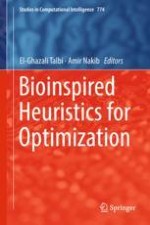2019 | OriginalPaper | Chapter
13. Algorithm Selector and Prescheduler in the ICON Challenge
Authors : François Gonard, Marc Schoenauer, Michèle Sebag
Published in: Bioinspired Heuristics for Optimization
Publisher: Springer International Publishing
Activate our intelligent search to find suitable subject content or patents.
Select sections of text to find matching patents with Artificial Intelligence. powered by
Select sections of text to find additional relevant content using AI-assisted search. powered by
